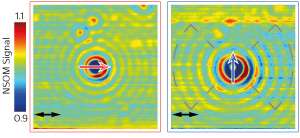Exciting silicon nanoparticles

A method to characterize and design the optical properties of silicon nanoparticles for their use on silicon chips has been developed by A*STAR researchers in collaboration with colleagues from Russia, Israel and Australia. The team were able to separate the electric and magnetic components of light resonances of silicon nanoparticles, promising new functionalities for optical components on silicon chips.
Thanks to their small size and shape, silicon nanoparticles have very different optical properties to those of larger slabs of the material, which allow them to be used as optical antennas to guide and direct light. "If you have silicon-compatible processes and computer chip nanolithography you can easily integrate good ideas into real devices using these silicon nanoparticles," explains Boris Luk'yanchuk from the research team, pointing out silicon's advantages over other optical materials.
The electric and magnetic components of a beam can be difficult to separate in the light scattered from the silicon nanoparticles, which prevents a full understanding of the nanoparticle properties. The experimental method developed by the team resolves this by combining different microscopy measurement techniques.
In the first step, polarized light of different wavelengths scattered by the nanoparticles when excited in the plane of the surface is studied using a regular microscope. In a second step, polarized light is used to excite the nanoparticles from underneath the surface, and the scattered light is collected by a small tip of an optical fiber. The combination of both experiments, where the silicon particles are excited at different angles, allows the electric and magnetic components of the scattered light beam to be determined.
The experimental approach promises the development of new applications, explains Luk'yanchuk. "The co-existence of strong electric and magnetic resonances, their interference and the resonant enhancement of the magnetic field in silicon nanoparticles brings new physics and entirely novel functionalities to the simple geometries of the nanoparticles."
Thanks to their ability to scatter light locally, the nanoparticles hold promise for the manipulation of light at length scales considerably smaller than the wavelength of light. This suggests that it may soon be possible to miniaturize silicon optical components as well as silicon electronic components. The ability to tune the electric and magnetic resonances separately permits a precise control over directivity and efficiency of the light scattering from the nanostructures.
More information: Dmitry Permyakov et al. Probing magnetic and electric optical responses of silicon nanoparticles, Applied Physics Letters (2015). DOI: 10.1063/1.4919536
Journal information: Applied Physics Letters





















